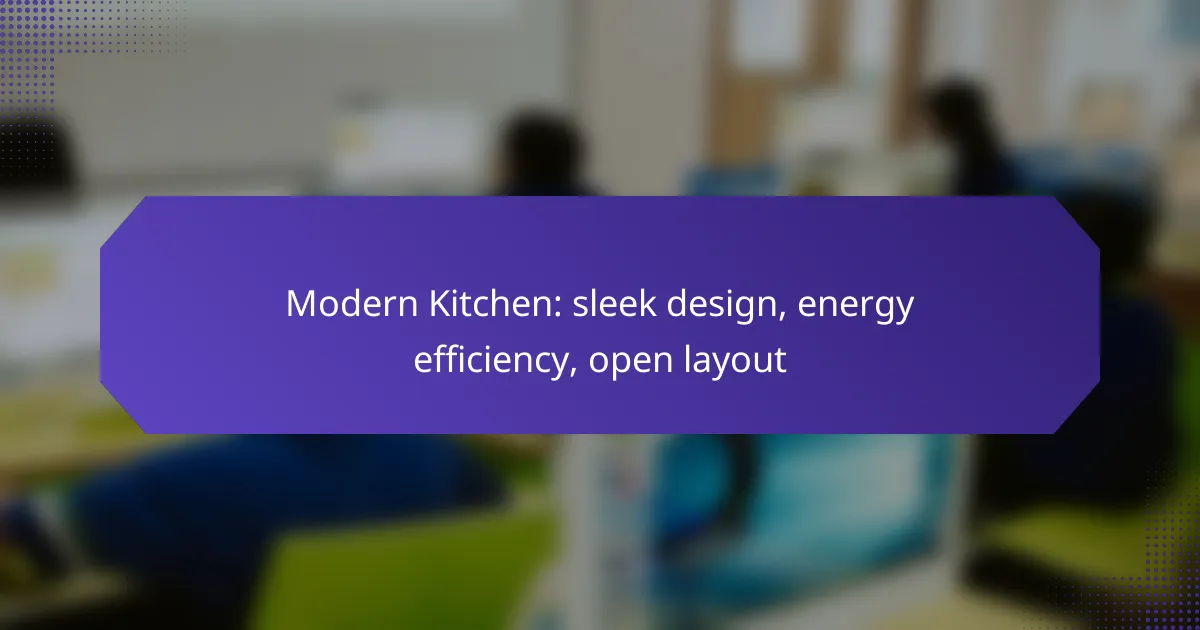A modern kitchen embodies a harmonious blend of sleek design and energy efficiency, characterized by an open layout that fosters connectivity and light. Utilizing materials like stainless steel, quartz, and glass, these spaces not only look stunning but also promote sustainability through energy-efficient appliances. This thoughtful design approach enhances both functionality and aesthetic appeal, making the kitchen a central hub of contemporary living.

How to design a modern kitchen in New York City?
Designing a modern kitchen in New York City involves creating a space that emphasizes an open layout, incorporates sleek materials, and maximizes natural light. These elements not only enhance functionality but also align with contemporary aesthetics and energy efficiency standards.
Open layout concepts
An open layout is essential for modern kitchens, especially in New York City where space is often limited. This design approach removes barriers between the kitchen, dining, and living areas, promoting a sense of flow and connectivity. Consider using an island as a central feature that serves multiple purposes, such as cooking, dining, and socializing.
When planning an open layout, be mindful of traffic patterns and ensure that the kitchen remains functional. Avoid overcrowding the space with too many furnishings; instead, opt for minimalist designs that keep the area feeling spacious and inviting.
Incorporating sleek materials
Sleek materials are a hallmark of modern kitchen design. Popular choices include stainless steel, quartz, and glass, which not only look contemporary but are also durable and easy to maintain. For cabinetry, consider high-gloss finishes or natural wood with clean lines to create a polished look.
When selecting materials, balance aesthetics with practicality. For instance, quartz countertops are not only stylish but also resistant to stains and scratches, making them ideal for busy kitchens. Aim for a cohesive palette that complements the overall design of your home.
Maximizing natural light
Maximizing natural light is crucial in New York City kitchens, where artificial lighting can often feel harsh. Use large windows or glass doors to invite sunlight into the space. If possible, consider skylights to enhance brightness, especially in darker corners.
In addition to structural changes, choose light-colored finishes and reflective surfaces to amplify the effect of natural light. Avoid heavy drapes; instead, opt for sheer window treatments that allow light to filter through while maintaining privacy. This approach not only makes the kitchen feel larger but also creates a warm and welcoming atmosphere.

What are the benefits of energy-efficient appliances?
Energy-efficient appliances offer significant advantages, including reduced energy consumption and lower operating costs. By using less electricity or gas, these appliances not only save money but also contribute to a more sustainable environment.
Lower utility bills
One of the most immediate benefits of energy-efficient appliances is the reduction in utility bills. These appliances typically use 10-50% less energy compared to standard models, leading to noticeable savings over time. For example, replacing an old refrigerator with an Energy Star-rated model can save a household around $200 annually on electricity costs.
To maximize savings, consider appliances with high energy ratings and look for features like smart technology that can optimize usage based on your habits. Regular maintenance, such as cleaning filters and coils, can also enhance efficiency and further lower bills.
Environmental impact
Energy-efficient appliances play a crucial role in reducing environmental impact by lowering greenhouse gas emissions. By consuming less energy, they decrease the demand on power plants, which often rely on fossil fuels. This shift helps to minimize air pollution and combat climate change.
Choosing appliances that meet recognized energy efficiency standards, such as Energy Star, can significantly reduce your carbon footprint. Additionally, many local governments offer incentives for purchasing these appliances, making them an even more attractive option for eco-conscious consumers.
Enhanced home value
Investing in energy-efficient appliances can enhance the overall value of your home. Prospective buyers often prioritize energy efficiency, viewing it as a long-term cost-saving feature. Homes equipped with modern, efficient appliances can attract higher offers and sell more quickly in competitive markets.
When considering upgrades, focus on key areas like kitchens and laundry rooms, where energy-efficient models can have the most impact. Highlighting these features in listings can appeal to buyers looking for sustainable living options, further increasing your home’s marketability.

Which materials are best for a sleek kitchen design?
The best materials for a sleek kitchen design include stainless steel, quartz, and glass. These materials not only enhance the aesthetic appeal but also contribute to energy efficiency and durability.
Stainless steel finishes
Stainless steel finishes are a popular choice for modern kitchens due to their sleek and contemporary look. They are resistant to stains and corrosion, making them ideal for high-use areas.
When selecting stainless steel, consider the gauge; lower numbers indicate thicker, more durable materials. Opt for brushed finishes to minimize fingerprints and smudges, ensuring a clean appearance.
Quartz countertops
Quartz countertops offer a luxurious look while being highly functional. They are non-porous, which means they resist staining and do not require sealing, unlike natural stone options.
Available in a wide range of colors and patterns, quartz can mimic the appearance of marble or granite without the maintenance hassle. Look for options that feature recycled materials for an eco-friendly choice.
Glass cabinetry
Glass cabinetry adds a touch of elegance and openness to a kitchen design. It allows for easy visibility of dishware and decor, contributing to an airy feel in the space.
When choosing glass cabinets, consider tempered glass for safety and durability. Frosted or tinted options can provide privacy while still showcasing your kitchen items, creating a stylish yet functional storage solution.

How to create an open layout in a small kitchen?
Creating an open layout in a small kitchen involves removing barriers and maximizing space to enhance flow and functionality. This can be achieved through strategic renovations, smart furniture choices, and incorporating elements that encourage interaction.
Removing non-load-bearing walls
One effective way to achieve an open layout is by removing non-load-bearing walls. These walls can often be identified by consulting with a structural engineer or contractor, ensuring that the integrity of the home remains intact. Removing these barriers can significantly increase the perceived size of the kitchen.
Before demolition, consider the layout and how the kitchen will connect with adjacent spaces. It’s wise to create a clear plan that includes plumbing and electrical considerations, as these may need to be adjusted during the renovation process.
Using multifunctional furniture
Incorporating multifunctional furniture is essential in a small kitchen to maximize utility without sacrificing style. Look for pieces like kitchen islands with built-in storage, drop-leaf tables, or stools that can be tucked away when not in use. These options can help maintain an open feel while providing necessary functionality.
Consider furniture that can serve multiple purposes, such as a dining table that doubles as a prep area or a cart that can be moved around as needed. This flexibility allows for a more dynamic use of space, accommodating various activities from cooking to entertaining.
Incorporating an island
An island can be a central feature in an open kitchen layout, providing additional workspace and storage. When selecting an island, ensure it fits comfortably within the space, allowing for at least 36 inches of clearance around it for easy movement.
Choose an island design that complements the overall kitchen aesthetic, whether it’s a sleek, modern look or a more traditional style. Including seating at the island can also create a casual dining area, enhancing the kitchen’s social aspect.

What are the latest trends in modern kitchen design?
The latest trends in modern kitchen design emphasize sleek aesthetics, energy efficiency, and open layouts. Homeowners are increasingly looking for functional spaces that blend technology with style, creating environments that are both inviting and practical.
Smart home integration
Smart home integration is a key trend in modern kitchens, allowing homeowners to control appliances, lighting, and security systems through their smartphones or voice assistants. This technology enhances convenience and can lead to energy savings by optimizing appliance use.
Consider installing smart refrigerators that monitor food inventory or smart ovens that can be preheated remotely. When choosing smart devices, ensure they are compatible with your existing home network and consider the ease of use for all family members.
Bold color palettes
Bold color palettes are becoming increasingly popular in modern kitchen design, moving away from traditional whites and neutrals. Homeowners are opting for deep blues, vibrant greens, and rich earth tones to create striking focal points.
When selecting colors, consider how they complement your overall home decor and the natural light in your kitchen. Pairing bold colors with lighter accents can create balance, while also making the space feel more inviting.
Textured surfaces
Textured surfaces add depth and interest to modern kitchens, moving beyond flat finishes. Materials like rough-hewn wood, matte metals, and patterned tiles are being used to create tactile experiences that engage the senses.
Incorporating textured surfaces can be as simple as choosing a backsplash with a unique pattern or opting for a countertop with a natural stone finish. This trend not only enhances visual appeal but also helps in hiding fingerprints and smudges, making maintenance easier.

What factors to consider when choosing kitchen appliances?
When selecting kitchen appliances, prioritize energy efficiency, brand reliability, and size compatibility. These factors will ensure that your appliances not only perform well but also fit seamlessly into your modern kitchen design.
Energy efficiency ratings
Energy efficiency ratings indicate how much energy an appliance consumes compared to its output. Look for appliances with high ratings, such as those labeled with Energy Star in the United States or A+++ in Europe, which can lead to significant savings on utility bills over time.
Consider the long-term costs associated with energy use. For instance, an energy-efficient refrigerator may cost slightly more upfront but can save you hundreds of dollars in energy costs over its lifespan. Always check the energy consumption figures, often displayed in kilowatt-hours (kWh) per year.
Brand reliability
Brand reliability is crucial when choosing kitchen appliances, as it reflects the manufacturer’s reputation for quality and service. Research brands known for durability and customer satisfaction, and read reviews to gauge user experiences.
Warranties can also be a good indicator of reliability. Brands that offer extended warranties often stand behind their products, suggesting confidence in their longevity. Look for brands with a solid track record in your region, as local support can be beneficial for repairs and service.
Size and fit
Size and fit are essential considerations to ensure that your appliances integrate well into your kitchen layout. Measure the designated spaces carefully, accounting for door swings and ventilation needs, to avoid any installation issues.
When selecting appliances, consider standard sizes, such as 30-inch ranges or 24-inch dishwashers, which are common in many homes. If your kitchen has limited space, look for compact or built-in models that maximize functionality without sacrificing style.










